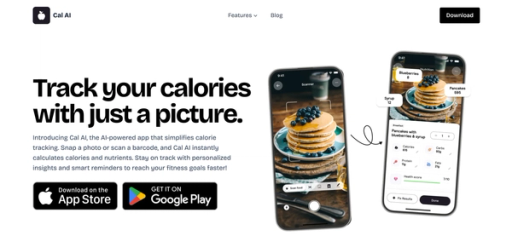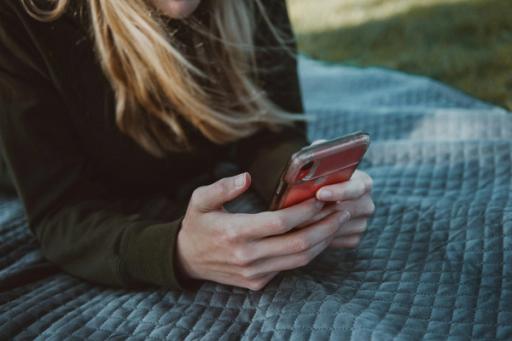
Keeping track of what you eat can feel like a slog, whether you want to lose weight or eat healthier for general wellness. Fortunately, food-tracking apps help simplify calorie tracking. The right app makes tracking meals easy, setting nutrition goals, and even adopting more nutritious eating habits. This article will help you find the best food journal app.
Cal AI's food calorie tracker is a valuable tool to help you achieve your nutrition goals. It’s easy to use and can help you find the best food journal app to make tracking meals simple so you can adopt healthier eating habits with minimal effort.

What we eat and drink affects our physical and mental health. So whether you're planning to lose weight or gain muscle, exercise more or sleep better, practice mindfulness, or reduce stress, you must be keenly aware of what you're putting into your body.
Calorie-tracking apps make it easier to log your meals. Instead of relying on memory to recall what you ate and how much of it, you can quickly enter meals into the app as you eat throughout the day. As a result, calorie counting becomes much more accurate.
You’ll see where your usual diet might be lacking in terms of nutrition. Do you eat enough lean protein every day? Are you getting enough fiber to keep my gut happy? Your journaling will reveal any dietary gaps, allowing you to adjust your meals accordingly.
You’ll have a better understanding of my snacking habits. Do I choose filling and nutritious snacks when I’m truly hungry, or do I reach for junk because I’m bored or stressed? You’ll learn more about the portion sizes I’m choosing. It’s okay to enjoy foods like crackers and pasta in moderation.
Are you piling your plate with more carbohydrates than necessary? Could you replace some of them with whole fruits and veggies?
A 2012 study from the Journal of the Academy of Nutrition and Dietetics found that women who kept food journals lost 13% of their body weight, compared to 8% for non-journalers. But a food journal can be great for men and women! A food journal can keep you accountable. Sometimes, we “forget” to think how much we ate that day. Sometimes, we don’t count calories as much as we could. Your awareness of your health and eating habits improves with a food journal.
Many apps can do this, but if you’re like me, you’ll do way better with something tangible you can hold. So, when you’re looking for the best food journal to fit your health needs, consider these factors:

Cal AI transforms calorie tracking with cutting-edge AI technology. Just snap a photo of your meal, and we'll do the rest.
Our app combines your phone's depth sensor with advanced AI models to:
With 90% accuracy on visible foods and multiple tracking options like:
We've made nutrition tracking effortless. Whether you're scanning a full meal or a quick snack, Cal AI
Our AI learns from your feedback to improve accuracy. It includes personalized insights and smart reminders to keep you on track. Cal AI makes achieving your fitness goals simpler than ever.
Track your calories with your camera using Cal AI's calorie tracker today!
Noom is a premium food journal app that offers personalized coaching and behavior change techniques, which makes it a popular choice for personal trainers and gym owners. With features like food tracking, daily challenges, goal setting, and an emphasis on behavior change and mental wellness, trainers can guide clients through a holistic approach to nutrition.
For example, trainers can use Noom to educate clients about proper portion sizes and help them develop mindful eating habits.
Lifesum is a popular food journal app that provides a range of tweakable features and meal plans that aim to “democratize healthy eating.” Trainers can leverage Lifesum to:
More than 55 million global users manage their nutrition planning using Lifesum, making it one of the most popular choices on the market.
Fitbit isn’t just a fitness tracker; it’s also a comprehensive food journal app, which makes it a solid choice for personal trainers and gym owners. Using Fitbit, trainers can seamlessly integrate nutrition tracking with Fitbit’s signature activity monitoring.
You and your team can set goals, view clients’ calorie balance, and assess their overall energy expenditure, providing a holistic health and fitness management approach.
You’ve heard of this one—everyone has it because it’s all over social media. MyFitnessPal is a popular free food journal app with a vast food database and in-depth tracking features. Personal trainers and gym owners can use it to monitor clients’ nutrition, set goals, and provide guidance. Its free online platform even gives you a calorie counter and diet plan — perfect for budget-conscious clients!
Lose It! is a food tracker jam-packed with logging and goal-setting features. Personal trainers and fitness pros use it to help clients monitor their food intake, create meal plans, and build accountability. The signature Lose It! five-step process is tailor-made to help with lasting weight loss, so if that’s your goal (or your client’s), it’s not a bad pick.
MyPlate Calorie Counter is a free food journal app built by the literal U.S. Department of Agriculture. It integrates with Amazon Alexa devices and smartwatches to make setting healthy eating goals a breeze. The Calorie Counter is perfect for educating clients about balanced nutrition, tracking their food intake, and setting goals. It’s easy to log meals with the MyPlate Calorie Counter, too — and the UI’s solid for a free tool.
FatSecret isn’t a secret! This free food journaling app provides comprehensive tracking capabilities and a supportive community. You can use it to monitor clients’ nutrition, help them start a food diary, and offer feedback. And that’s not all — a solid online community is also attached to the app. It’s perfect for guiding clients in making healthy food choices, sharing meal ideas, and getting engaged with their nutrition.
Fooducate is yet another solid free food journaling app. It goes beyond tracking and teaches users about nutrition, which helps them lock into long-term habits. Trainers can use Fooducate to educate clients about food quality, ingredient lists, and the foundations of proper nutrition. Your clients can use Fooducate’s barcode scanner to access the app’s extensive nutritional information database quickly.
Like MyFitnessPal and its many alternatives, BiteSnap recognizes what you eat by snapping a photo and automatically adds nutritional information. The best part is that it's free, ad-free, and has no restrictions. You can add photos from the past or take a live picture. You can also scan bar codes to add packaged items automatically.
The database includes over 1300 items and uses machine learning to match what's on your plate to the ingredients or dishes in the database. If an item isn't in the database, you can add it manually and specify its nutritional values too.
While logging a food entry, you must add the quantity consumed. BitesSnap will calculate your calories and macros accordingly and display them on the main dashboard so you can find your consumption values at a glance. You can export all your data as a CSV or JSON file for free!
If photos aren't your thing and you want a way to add what you ate and move on quickly, OmNom Notes is an excellent choice. Logging a new entry lets you search for food items online through USDA FoodData Central and OpenFoodFacts databases. The latter is among the best apps for understanding nutrition and healthy eating.
It tracks the nutritional values of everyday food items and has a vast catalog that covers almost every food item you come across. You'll be done adding an entry in no time.
WW is another popular food journaling app with a huge database and a firm community base. Alongside normal food journaling, it also offers an option where the user has to enter the brand of food or meal they are taking alongside the quantity to get a very accurate breakdown of the nutritional content.
Note that this application requires a subscription. Strong community support. Users can use built-in recipes to cook healthy meals. Alongside food journaling, it supports water intake and sleep tracking.
Yummly is more than a basic food journaling app. If you want to cook a meal by yourself and are confused about the content and type of food you should use, this app is for you. Unlike other apps, Yummly provides food recipes and a detailed breakdown of what your body will get from it.
It is the perfect app for those who want to cook healthy meals. If you have smart appliances, you can connect them to the app for more information. The app is majorly free with an optional subscription plan.
Cronometer breaks down the calories, food groups, macronutrients, and vitamins and minerals you consume to see if you meet your needs. The barcode scanner function makes it easy to log food fast, and the database includes tons of food brands, allowing you to get more accurate information.
You can customize your reports and recommendations to adhere to a diet, such as keto, paleo, or vegan. If you're pregnant, the app can personalize your profile to meet higher calorie needs. As a bonus, you can log your physical activity within the app, which integrates Fitbit, Apple Watch, and many other popular fitness trackers to see all your health data in one place.
If you’re new to food journaling or are a visual learner, the See How You Eat app is a good place to start. You record your meals and snacks by snapping photos of them with your smartphone, and these photos become your journal entries.
It’s linked to an 80/20 Coach app by the same developers that can help you improve your food choices and portion sizes. Both apps are free to download; many advanced features are available as in-app purchases.
Like See How You Eat, the Ate Food Diary + Habit Tracker app tracks your food via the photos you upload. You’ll spend a few minutes reflecting on what you ate and why, which can make you more mindful of your food choices.
If you’ve ever explored the benefits of journaling for mental health, think of the Ate app as a journal dedicated to your eating habits. The app and its basic features are free, with the option to purchase a premium membership.
If you’ve ever experienced symptoms of a food allergy or sensitivity, the Cara Care app may be a lifesaver. This app focuses on your body’s response to your eating, especially as it applies to your gut health. Do you struggle with issues like bloating, constipation, or heartburn?
Tracking your meals and snacks on Cara Care can help point to eating patterns that may be problematic for your GI tract. If you’ve been diagnosed with IBS, IBD, Crohn’s, GERD, or another digestive disorder, Cara Care can help you get your symptoms under control. It’s free to download, with many in-app purchases available.
Your food and drink consumption, sleep patterns, and physical activity determine how you feel daily. But when your health (physical or mental) is off despite following daily routines, finding patterns behind the cause can be difficult. That's where mySymptoms helps by logging all your body's behavior and outcomes. You can track the following:
Of course, each has its different items, and the most commonly added things get stored as your favorites to find them quickly. Over time, mySymptoms will find connections and patterns within your consumption, lifestyle, and feelings.
The free online Mindful Eating App by MindfulDevMag is a diary for mindful eating practice. When you open the app, it automatically updates the date and time (although you can change this manually). Log how hungry you were before and after eating on a scale of ten. Then, write what you ate, followed by what I felt before, during, and after eating.
If I have any other thoughts and feelings, I can log them in the journal. There is no installation in this app, nor can I sign up for an account. All my data is stored in the browser cache and viewable in the Dashboard, so I always write my mindful eating diary from the same browser. I recommend turning it into a Chrome app on my phone and using that repeatedly.
If apps aren't your thing, The Ingredient Guru has a great food mood journal that you can download and print for free. It's a daily food diary on a standard sheet that you'll fill with a pen and track other things like your mood, exercise levels, and general state.
The journal has slots for seven food entries per day, in which you fill the time, location, food or beverage consumed, and amount, and log an emoji describing my mood before and after. It also reminds me to drink more water by asking you to log how many 8oz glasses of water I've had in the day.
Calorie-counting apps can trigger or worsen disordered eating behaviors for some people. Rise + Recover is an excellent choice if you're in recovery from an eating disorder and want to use a food journal for reasons other than weight loss. This app incorporates many elements of cognitive behavioral therapy (CBT), which evidence supports as an effective treatment for reducing all types of disordered eating behaviors.
While you do track the foods you eat within the app, there's no calorie information. Instead, this app emphasizes tracking the emotions and thoughts you experience around meal times—so you can recognize how those feelings affect your eating habits.
Ate is a good option if you're trying to develop more mindfulness around eating and step away from micromanaging your food intake. This app works as a visual food diary, where you can quickly and easily log your choices and track how they make you feel.
You notice while journaling that you often overeat when bored or stressed. Identifying those emotional triggers can help you find alternative ways to deal with them—like going for a walk or calling a friend. The app can also record your movement and other aspects of your health, like:

Choose the food journal format that works best for you. You might find an app more straightforward than a physical journal you must remember to bring everywhere—especially if you continually keep your phones on you. Also, apps can quickly analyze all your data for meaningful insights. But you do have hard copy options that work. You don't need to buy a fancy journal—any notebook can do the trick.
Log your meals right away. The more time passes, the greater your chance of forgetting what or how much you ate. That's why experts recommend journaling while you eat or immediately after you eat for the most accurate data.
Make a note of your mood, circumstances, and feelings around meal times. Factors like who you eat with, where you eat, and the emotions you feel before and after eating can all affect what and how much you consume. For example, you may discover via food journaling that you have trouble making balanced eating choices when alone.
Or, when I grab sugary breakfast foods like pastries when I'm short on time, I end up having a second breakfast two hours later. That's why dieticians strongly suggest recording. Your thoughts and feelings right before and after eating. Who are you eating with, if anyone? What are your energy levels before and after eating?
Once you've noticed these patterns, you can make changes, like making time for a breakfast high in protein and fiber instead.
If your goal is weight loss, measure portion sizes whenever possible. When it comes to losing weight, it's not just about what you eat but also how much you eat. About half of the calorie intake errors on these apps happen due to incorrect estimates of portion sizes. That's why experts suggest investing in measuring cups, measuring spoons, and a food scale to get a better sense of portion sizes. Entering the right portion sizes for your eating will ensure you get more accurate data reports.
Cal AI is an app that transforms calorie tracking. Just snap a photo of your meal, and we'll do the rest. Our app combines your phone's depth sensor with advanced AI models to:
With 90 percent accuracy on visible foods and multiple tracking options like barcode scanning, food label recognition, and manual descriptions for complex items like smoothies. We've made nutrition tracking effortless. Gone are the days of tedious manual logging. Whether scanning a full meal or a quick snack, Cal AI gives you accurate nutritional information in under fifteen seconds.
Cal AI uses advanced artificial intelligence to analyze your meals and calculate their nutritional values quickly. To achieve this, the app utilizes your smartphone's depth sensor to detect food volume and uses AI algorithms to identify the specific items within your meal.
This combination of technologies allows Cal AI to get you accurate results in seconds. The app even learns from your feedback to improve its accuracy over time.